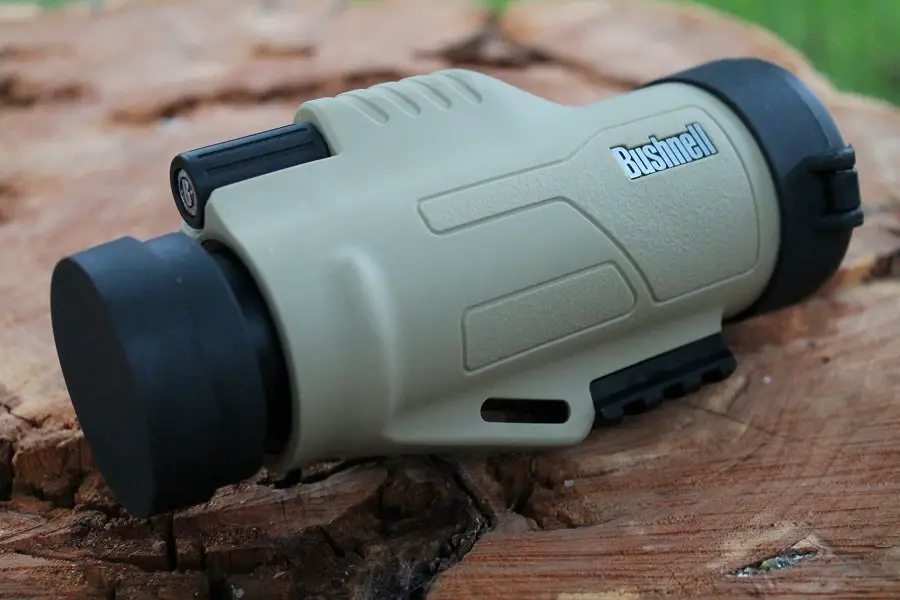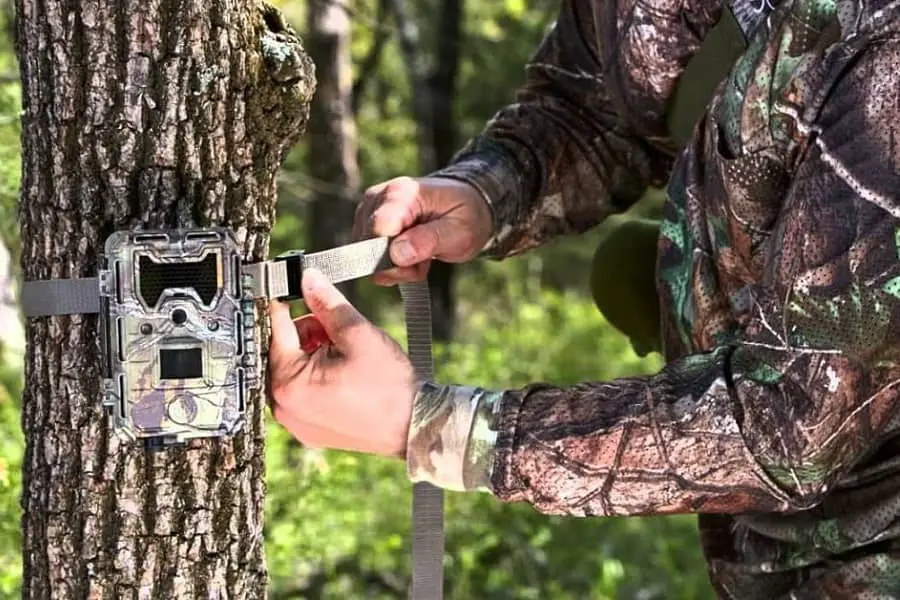If you’ve ever wrestled with a pair of binoculars with your hands full, you’ll understand the appeal of the monocular.
Monoculars are the perfect, compact way for you to see things that are far away without over encumbering yourself.
By using multiple lenses to refract light back at you, you can pick out objects that are far away with ease.
Let’s explore the best monoculars on the market!
Our Top Pick
Bushnell Night Vision Monocular
Why is it better?
- Water resistant housing repels rain and other light water
- Infrared night vision mode up to 500 feet
- 1x to 3x optical zoom distance
5 Best Monoculars For Hunting
With that in mind, let’s now take a closer look at our top picks.





Let’s dive into the specifics and review each monocular individually. You can use the list below to jump and review specific models, or you can read along and go through all the information.
Best Overall: Bushnell Night Vision Monocular
Bushnell is one of my favorite brands because it has so many different products that I used during my childhood years, things I didn’t even realize until later on in life.
Their Equinox Z is the one-in-all kind of monocular that you should already be using. Between the compact size and ultralight design, it’s basically the perfect side compartment companion.
You can put it on the exterior pocket of your soft rifle case, and hit the trail to find your prey.
Using the infrared illuminator, you can see up to 500 feet in the dark, giving you an edge of whitetail deer in the early morning hours when they’re feeding and drinking.
If you do hunt early morning, you might be wondering if the fog and early morning dew is going to be a problem.
Bushnell made this waterproof, fogproof, and minorly shock resistant, so even if you drop it in the middle of the woods it doesn’t run the chance of getting damaged quite so easily.
Pros
- Water resistant housing repels rain and other light water
- Infrared night vision mode up to 500 feet
- 1x to 3x optical zoom distance
Cons
- Little hard to get accustomed to
Firefield Night Vision Monocular
I think we all enjoy ultralight items when we’re hunting or camping. You need functional equipment, but you don’t want it to weigh a ton.
Sometimes I don’t want binoculars around my neck, which is when Firefield’s Nightfall monocular comes in handy. Designed to be extremely compact, the Nightfall comes with a subtle adjustment dial and simple operation.
Firefield wanted to lengthen the life of this monocular, so they added a pulse dampener, as I call it, that actually makes the illuminator last for longer without needing a new charge. Generally speaking, the smaller an optic is, the less it can do.
You still need a lens and light transmission through a prism to get the job done. Firefield managed to give you a 5×50 optical zoom on this despite its miniature size, while making the whole thing completely weather resistant.
The last thing I want to talk about is the price. They give massive discounts to Amazon Prime customers, which can shave off some big dollars. Even so, at list price, Firefield made one damn fine piece of equipment here that lives up to their brand name.
All of this additional security was so impressive, that even the uptight California DOJ has approved it for home use in and around your family. This is what fortification looks like.
Pros
- 5×50 scope for excellent range in most situations
- Power-saving illuminator keeps things lit up without killing your charge
- Ultra compact and lightweight size fits anywhere
Cons
- Bit too small
Bushnell Legend Ultra HD Monocular
- ULTRA-CLEAR OPTICS: With our advanced ED Prime glass and Ultra Wide...
- VERSATILE MAGNIFICATION: The 10x magnification is ideal for a wide...
- DURABLE AND WATERPROOF: The Legend Monocular is built to withstand the...
This is true monocular, designed without an additional lens or add-on: just strictly a monocular. Bushnell was able to sneak in their features without it taking away from the aesthetics of the classic design.
Most notably, the alteration dial is snuck underneath the slight bump along the top. Fitted with a rubber grip along key finger contact points along the entire monocular, making it fit perfectly in your hand with little to no issue.
The real magic comes into play when you take a look at what the lens offers you. Multi-coated ED prime glass lenses give you unparalleled level of magnification and clarity when you look through the prisms, which is pretty fantastic for such a low price point.
If you’re essentially heading your hunting party, you can buy them in bulk for a small percentage off of each individual monocular.
Look through those BaK-4 prisms and tell me that it isn’t better than any half-baked binoculars that you’ve used over the years. Use up to 10x magnification, and spot your prey from hundreds of yards away like a true hunter.
Pros
- Multi-coated ED prime glass lenses
- BaK-4 prisms provide better light emission
- Completely waterproof and fogproof construction
Cons
- Bit too pricey
Vortex Optics Solo R/T Monocular
Vortex is back in the mix, because how could they not be? As one of the top brands of tactical optics out there, they put their best foot forward to continuously make inexpensive gear that rivals the rest of the market.
Grasp onto the textured grips and feel the perfectly lightweight and compact size in your hand, while the rubber eyecup contours to the shape of your eyes when you look through them.
I’ve run into a lot of eye cups on binoculars and other optical gear, and they usually rub your skin the wrong way or leave an odd feeling on your skin. Thankfully, this one doesn’t.
Utilize the 8×36 optical zoom feature to get up close and personal to your targets, without actually getting up close in personal.
Adjustments are almost a little too easy, which is something you need to be on the lookout for. When this is hanging from the utility clip, it’s easy to grab it incorrectly and turn your dial. It’s a quick fix, but a design flaw.
Pros
- Triple locking system for fortified security
- Holds up to ten rifles with room to spare
- Padded foam bottom and barrel rests
Cons
- No biometrics
Wingspan Optics Titan Monocular
Last on our list is the Wingspan Titan version, one of the most affordable monoculars I’ve ever had the pleasure of using. For a low price, it packs some serious zoom function at 12x50mm. That’s pretty good considering its very compact size.
The lightweight design doesn’t have a lot of grip to the exterior, which can be a problem.
I personally find that getting some adhesive rubber strips (about a buck a strip) is beneficial for such a smooth exterior. It sticks on well, and provides the right amount of traction.
Wingspan made this fully waterproof with a fogproof design to protect the prisms and lenses. This withstands light rain and falling onto the wet ground, but it’s not a high enough waterproof rating to be submerged.
It should be noted that Wingspan also offers a lifetime warranty, and provides a 30-day money-back guarantee if you’re not happy with this monocular.
As a word of the wise, it starts from the purchase date, so if you receive it three days after purchase, you have 27 days to contact customer service and request a refund.
Pros
- Lifetime warranty covered by the manufacturer
- 12×50 zoom in a compact size
- Fully waterproof and fogproof design
Cons
- Lack of quality grip
Types Of Monoculars
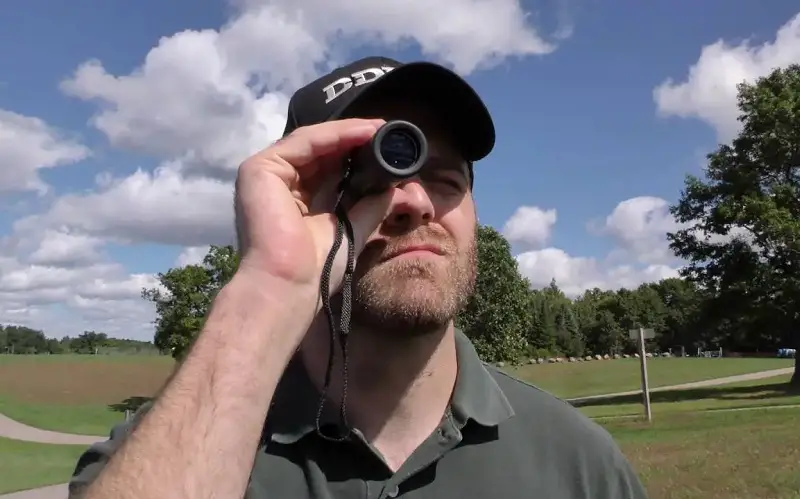
The first type of monocular is the basic, or golf-spotter, monocular.
Most commonly used to see down the course from a distance, these monoculars are as basic as it gets. They allow you to see far away objects up close and may include a small strap or handle on the side to make them easier to use with your off hand.
Most models are not waterproof or night vision equipped, as they are meant for use in direct or partial daylight. These are good for casual hunters, or for the outdoorsman who wants to take in the view without taking in a full set of binoculars.
The next type of monocular is the more advanced model that includes things like tripods, night vision, and waterproofing to increase durability and stability.
Usually used by bird watchers and hunters, these monoculars are often times compatible with cellphone cameras, allowing you to take a snapshot of your quarry.
Night vision monoculars are perfect for those early mornings and dwindling hours of hunting, so you can see in the distance without having to wrestle with a full (and expensive) set of night vision goggles.
As with the regular model, these monoculars usually include some form of hand strap to ensure stability, and can also include adjustable eyepieces and a more precise zoom lens for that perfect shot.
No matter the need, monoculars can help you keep your eyes on the prize while in the woods, in your backyard, or anywhere you want some added zoom.
Make sure to research what you need in a monocular before purchasing one to ensure that you get the right lens for your needs.
What You Should Know About Monoculars
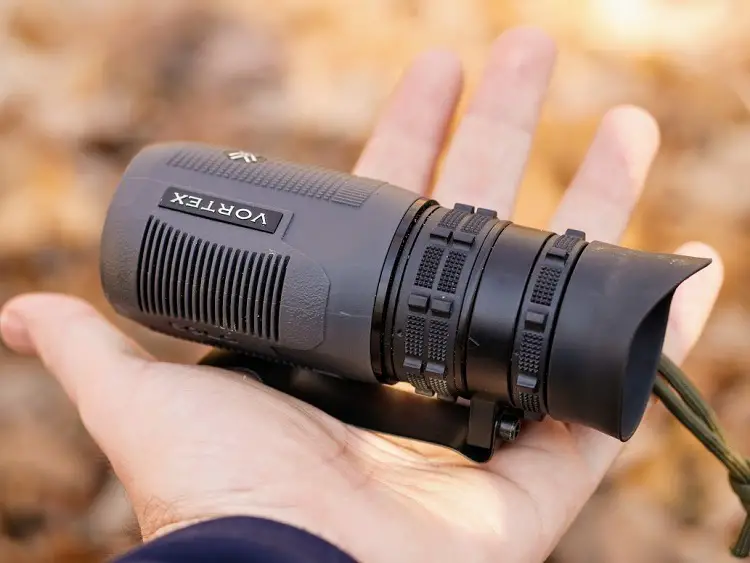
Monoculars are made to be usable with one hand so that you can use them to see far-away objects without wrestling with your gear.
They are also more compact than a set of binoculars or a telescope, meaning you get the added benefits of being able to see your target far away without having to hike in extra equipment.
There are a number of different varieties of monocular, each with its own strengths and ideal purpose. But for those of you in a hurry, our pick for the best hunting monocular is the Bushnell Equinox Z.
This unit has a great set of features for anyone looking for a spotting monocular for hunting. Monoculars come in a wide range of types and designs, from basic to more technologically advanced monoculars that include night vision settings.
Some digital monoculars are compatible with cell phones, allowing you to get that far away shot you’ve always dreamed of.
FAQs
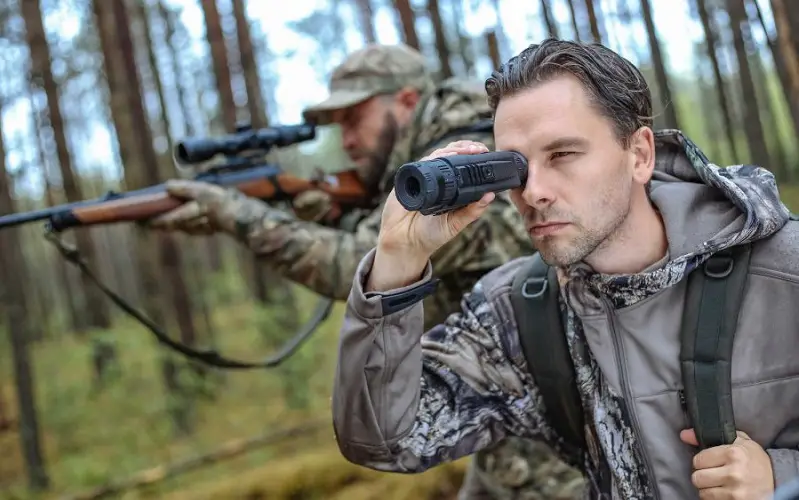
WHAT ARE MONOCULARS USED FOR?
They’re like little pocket telescopes. You’ll see me make references to telescopes when we talk about weapon scopes in other articles. A monocular is used for spotting prey at a far distance during hunting.
Personally, I also have one in my bug-out bag, because you always need to survey the area that you’re headed to in a SHTF scenario. They can take the place of a spotting scope or a pair of binoculars while hunting.
They’re much more compact and easy to transport, so for the ultralight hunter, these are the best thing you could possibly have by your side.
HOW DO MONOCULARS WORK?
Using prisms and lenses, light is filtered through to increase the size of an image. You have an eyepiece lens and an objective lens.
The latter gives you an image, runs it through the prism, and you receive an altered and magnified image through your eyepiece lens. The science behind it all is much more difficult than that, but those are the basic fundamentals of how it works.
Prisms may also be used to direct light away during magnification to give you a variable zoom length, or allow you to alter the image with a magnification knob.
WHAT DO THE NUMBERS MEAN ON MONOCULARS?
With any optic, the first number (such as a 9x40mm) tells you the magnification power, and the second number relates to the objective lens on the front. This is all relative to size. Both affect what you will be able to see.
For instance, if your magnification number is 8, you cannot possibly magnify an image more than that. The second number relates to the objective lens, as mentioned before, but it’s the size or diameter of the objective lens.
A larger objective lens allows more light to be filtered through the lens, and therefore brings more capabilities to your monocular. You’re not going to see many optics in general with a 2x50mm rating, or vice versa with a high magnification and low diameter on the objective lens.
CAN YOU USE BINOCULARS WITH ONE EYE INSTEAD OF MONOCULARS?
You can, but what would be the point? In general, monoculars (or rather, a monocular) would be far less expensive than a pair of binoculars.
If you find yourself squinting one eye closed while trying to spot animals or just use your binoculars for fun, then you should consider swapping it out for a monocular.
They’re more lightweight and easier to use. If you’re using one eye out of a pair of binoculars, you still have to support the other side that isn’t being used.
Monoculars were designed to be one-handed, so if you have a gun in one hand, you can have a monocular in the other to make spotting infinitely easier.
Resources:


